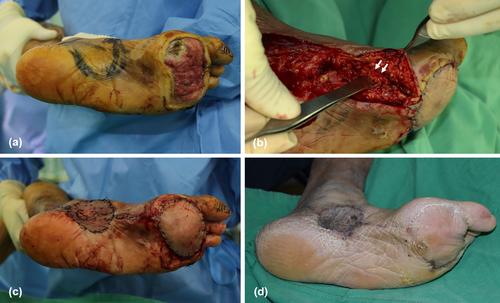Comparison of instep and non-instep flap in the reconstruction of the weight-bearing portion of the forefoot and heel
Abstract
Background
Instep flaps are commonly used for the reconstruction of weight-bearing areas of the foot. However, in cases of large defects or damage to the instep area, non-instep flaps such as reverse sural flaps (RSF) or free anterolateral thigh flaps (ALTF) can be employed. Previous studies have primarily focused on heel reconstruction when comparing different flaps, without considering the forefoot. This study aims to verify the clinical outcomes of these flaps and determine the appropriate donor site for weight-bearing areas of the foot including forefoot reconstruction.
Methods
In a retrospective study, 39 patients who had undergone flap reconstruction of weight-bearing area defects in the foot with a follow-up period of ≥1 year were included. The patients were categorized into two groups: Group A (n = 19) using instep flaps, and Group B (n = 20) using non-instep flap including RSFs and ALTFs. Surgical outcomes were assessed based on the success of the flap, the presence of partial necrosis, the number of additional surgeries, and complications related to the donor site. Clinical evaluation included visual analogue scale (VAS) and American Orthopedic Foot and Ankle Society (AOFAS) score, and the occurrence of ulcers.
Results
All flaps were successful, while partial necrosis occurred in one case in Group B. There were three reclosures after flap border debridement in both groups and one donor site debridement in Group A. The VAS scores during weight-bearing were 2.0 ± 1.1 and 2.2 ± 1.5 for Groups A and B, respectively (p = .716). The AOFAS scores were 52.8 ± 6.8 and 50.2 ± 12.7 for Groups A and B, respectively (p = .435). The occurrence of ulcers was 0.4 ± 0.9 times for Group A and 0.3 ± 0.7 times for Group B, with no significant difference between the two groups (p = .453).
Conclusion
There was no difference in clinical outcomes between the types of flaps after reconstruction of the forefoot and hindfoot. Therefore, it is recommended to choose the appropriate flap based on factors such as the size of the defect, its location, and vascular status rather than the type of flap.


 求助内容:
求助内容: 应助结果提醒方式:
应助结果提醒方式:


